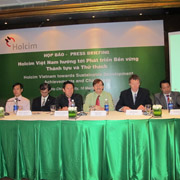IUCN-Holcim relationship
Press Conference, HCMC, March 10, 2011: The extraction of minerals often has a large and sometimes irreversible impact on plants and animals in surrounding areas. Yet the demand for minerals, including limestone for cement production, is growing. Just saying “no” to mining is rarely a practical option.

Photo: Holcim Vietnam
To address these challenges, in 2007 IUCN and Holcim entered into a 4-year engagement and established an independent panel of experts to develop a biodiversity management system for the entire Holcim Group. As a result, Holcim integrated biodiversity conservation into its environmental policy and tools and has set a very strong biodiversity goal: by 2013, Holcim will achieve its target of having a plan to protect biodiversity at 80% of its quarries in environmentally sensitive areas.
The success of the first phase has led the two partners to renew the engagement. On March 2, 2011, Holcim and IUCN signed a new 3-year agreement that focuses on the implementation of the recommendations from the first phase. This global engagement builds on country based partnerships, including the one that IUCN Vietnam and Holcim Vietnam signed in 2008.
Vietnam is highly environmentally sensitive by virtue of its rich diversity of plants and animals and the fact that many of these plants and animals only live in Vietnam and nowhere else in the world.
The province of Kien Giang in southern Vietnam, where Holcim has a quarry and cement plant, is particularly sensitive because the limestone hills are separated by hundreds of kilometers from the limestone that covers much of central and northern Vietnam. As a result, the plants and animals that inhabit them have evolved separately.
Over several years Holcim has supported surveys, field interventions, and consultations with local communities and government to address its environmental impacts in Kien Giang. As a result, a strong scientific basis has been established on which to develop the biodiversity action plan for Holcim’s quarry and plant.
A central element of this plan is the proposal to compensate for the unavoidable impacts of limestone quarrying and clay extraction by strengthening management of areas of equal or higher biodiversity value nearby. This will involve the establishment of two new nature reserves, one to protect the remaining limestone hills and the other to protect the remaining natural grasslands. This “biodiversity offset” approach is new and an exciting learning experience for both IUCN and Holcim.
IUCN Vietnam and Holcim Vietnam will complete the biodiversity action plan in 2011, well in advance of the 2013 deadline. IUCN and Holcim have also worked together on a series of summer campaigns to raise environmental awareness of local people and government officials around Holcim’s four plants in southern Vietnam.
But a successful partnership with Holcim is not enough; we also need to engage the state-owned cement companies in Kien Giang that collectively produce more cement that Holcim. Engaging these state-owned companies is difficult, however. Government may face a conflict of interest between its role as owner and regulator and may be reluctant to enforce regulations that increase costs or result in job loses. This makes improving the environmental performance of state-owned enterprises very challenging.
